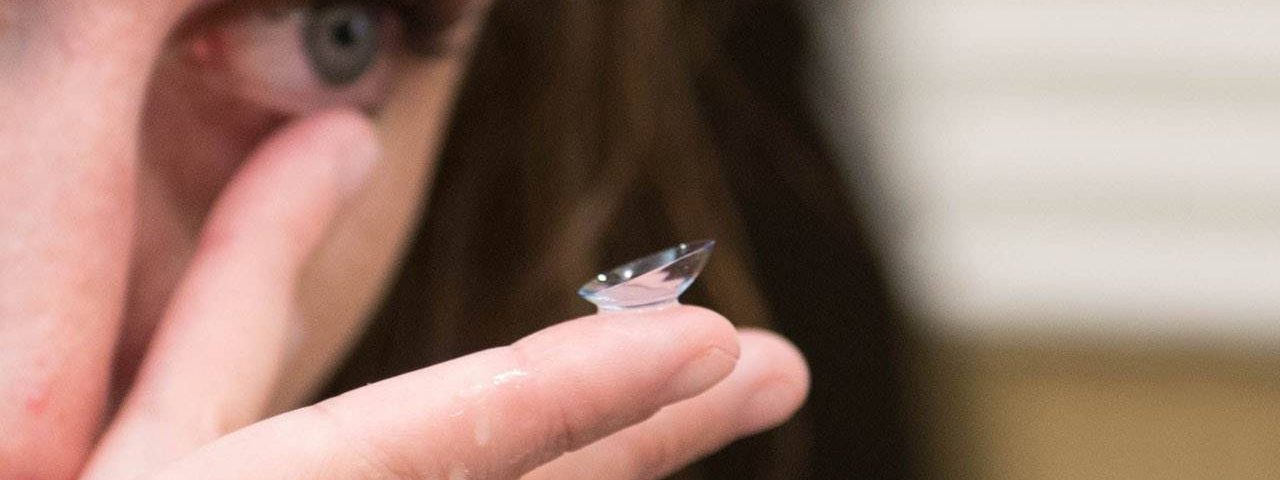Step 1: Comprehensive Eye Health Exam
To begin, your eye doctor will perform an examination that is essentially the same as a regular eye health exam. This is done in order to make sure you don’t have any pre-existing health conditions that may interfere with comfortable and healthy contact lens wear. Your optometrist will administer a slit lamp examination to inspect the inner tissues of your eyes carefully.
Also, you need a current vision prescription for contact lenses, so vision testing is a critical part of this exam. Once your vision condition and ocular health are determined suitable for contact lenses (nowadays, there’s a contact lens for almost everyone!), the next step is a precise contact lens fitting.
Step 2: Contact Lens Consultation
Now that there are so many types of contact lenses on the market, your eye doctor needs to know about your lifestyle and activities in order to determine which lenses are most appropriate.
Questions to consider:
- Do you want daily disposables (dailies), or contacts that can be worn for more extended periods?
- Do you want to change your eye color?
- Do you prefer soft or rigid gas permeable lenses? Ask your optometrist to explain the pros and cons of each type.
- If you have presbyopia – are you interested in multifocal contacts, or would you rather wear reading glasses over single-vision contact lenses? Monovision is another technique to treat presbyopia; ask your eye doctor how it works.
- Do you plan to wear your lenses daily, or only for special occasions and activities?
The range of contact lens options is vast and the more information you share, the easier it will be for your eye doctor to recommend the best contact lens to satisfy your requirements.
Step 3: Contact Lens Fitting
Depending upon your eyes, various technologies may be used during your fitting. An improper contact lens fit can lead to pain or damage your eye, which is why it’s so important to have a precise and thorough fitting.
A number of measurements are significant for determining your contact lens prescription, including:
Corneal Curvature
Generally, your eye doctor will use a keratometer to measure the curve of your cornea, which is the front surface of the eyes – where contacts rest. These numbers help to determine the lens diameter and base curve that appear on your contact lenses prescription.
Corneal topography is an advanced technology that maps the shape of your cornea. This test is extremely helpful for ensuring a precise measurement of your corneal curvature, especially when you have an irregular shape. There are numerous specialty contact lenses that can be fit on an irregular cornea. For example, people with astigmatism may do best with specialized toric lenses or if you have keratoconus, your eye doctor may prescribe scleral lenses.
Pupil and Iris Size
Either a slit lamp or a hand-held ruler can be used to take these measurements. The size of your iris and pupil play a role in figuring out the best contact lens design for you. This information is particularly important if you are interested in hard gas permeable contact lenses (GP).
Assessing Tear Film
Contact lenses are more comfortable to wear when you have enough lubricating tears to keep both your cornea and your lenses moist. Your eye doctor may evaluate your tear film by placing a thin strip of filter paper under your lower lid. Another procedure that may be done involves placing liquid dye on your eye and assessing your tear film with the aid of a slit lamp. If you have dry eyes, you will require specific types and materials of contact lenses.
Step 4: Time to Try a Pair of Contact Lenses
After your contact lens fitting, the best way to assess a perfect fit is with a pair of trial lenses. Once these contacts are on your eyes, your optometrist will check with a slit lamp to see that your lenses move properly when you blink and look in all directions. At this point, patient feedback is very important; tell your doctor if the lenses are comfortable or if they hurt.
Once a trial pair is found to be suitable, you will be issued a contact lens prescription. Your eye care provider will also instruct you on proper insertion, cleansing, wearing schedule and basic care of your contacts.

Walmart Eye Doctor Olathe, KS – Experts In Contact Lens Fittings
Step 5: Your Contact Lens Prescription
A complete prescription for contact lenses generally includes the following information:
OD and OS: These letters refer to your right eye (OD) and left eye (OS), based on the Latin terms.
PWR: Refers to refractive power, which is the value of correction that you need in order to have 20/20 vision. The number is measured in diopters; if it has a minus sign before it, it means you are nearsighted, and if it has a plus sign before it, it means you are farsighted. It is typical to have a different power for each eye.
BC: This is the Base Curve (measured in millimeters), which describes the back curvature of the contact lens. The number matches your corneal curvature. Some brands of contact lenses only come in one base curve.
DIA: The Diameter of your contact lens is the distance across the lens surface, also measured in millimeters. Usually, the number is between 13 and 15. This value determines how the contact lens sits on your eye, and when it isn’t appropriate for you – the contact lens will be uncomfortable.
If you require toric lenses for astigmatism, the following information is also included:
CYL: Cylinder value, generally between -4 and +4, it is the power required to fix your astigmatism
Axis: Written in degrees, the axis describes the orientation of the cylinder value on the lens
If you need bifocal or multifocal lenses, your contact lens prescription will also state:
ADD: The Add Power, which refers to the power of magnification that you need in parts of the lens to help see up-close
Your prescription may include a specific brand of contact lens if your eye doctor recommends a certain type for your eyes. If you desire cosmetic colored lenses, those details will also be written. Sometimes, the prescription will detail how often you need to discard and replace the lenses.
Step 6: Follow-up Visits
To ensure that your contact lenses continue to fit properly and provide you with sharp vision, you will need to return for follow-up visits. Your eye doctor will also examine the health of your eyes to confirm that your eyes can tolerate contacts with no problems. Sometimes, a change in the material of your contacts, brand or wearing schedule is necessary.
Notes: Galbrecht Eyecare takes most insurance plans, please click VISION INSURANCE for more information and call us. To help you get your insurace verified before your visit please contact our Insurace department and get the expert vision care you deserve. Phone us at 913-764-9300





